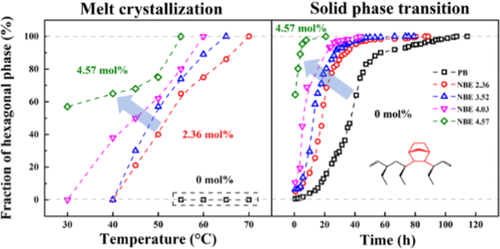当前位置:
X-MOL 学术
›
Macromolecules
›
论文详情
Our official English website, www.x-mol.net, welcomes your feedback! (Note: you will need to create a separate account there.)
Influence of Steric Norbornene Co-units on the Crystallization and Memory Effect of Polybutene-1 Copolymers
Macromolecules ( IF 5.5 ) Pub Date : 2020-03-12 , DOI: 10.1021/acs.macromol.0c00078 Yilong Liao 1 , Long Liu 1 , Zhe Ma 1 , Yuesheng Li 1, 2
Macromolecules ( IF 5.5 ) Pub Date : 2020-03-12 , DOI: 10.1021/acs.macromol.0c00078 Yilong Liao 1 , Long Liu 1 , Zhe Ma 1 , Yuesheng Li 1, 2
Affiliation

|
The incorporation of the secondary co-units may not only change the kinetics and polymorphism of crystallization but also affect the melting behavior of polymers, leading to the memory effect even above the equilibrium melting temperature. In this work, a series of butene-1/norbornene random copolymers with 0–4.57 mol % steric norbornene (NBE) co-units was synthesized using rac-ethyl(1-indenyl)2 zirconium dichloride as the catalyst. The melt crystallization, solid-phase transition, and memory effect associated with incomplete melting were studied with differential scanning calorimetry and in situ wide-angle X-ray diffraction. The results show that unlike the polybutene-1 homopolymer, which always generates tetragonal crystals, the presence of steric NBE co-units can cause the copolymers to crystallize into trigonal form I′. The correlations of crystallization polymorphism with the NBE concentration and temperature were quantitatively established. For copolymer NBE2.36, the threshold temperature for generating pure form I′ crystals is 70 °C, and this decreases to 55 °C when the NBE concentration is increased to 4.57%. Moreover, for crystallized tetragonal form II, its spontaneous phase transition into thermodynamically more stable form I was significantly accelerated. On the other hand, the melting behaviors of the copolymers were influenced by the incorporation of NBE co-units, leading to the appearance of a memory effect. Interestingly, the memory effect not only accelerates the crystallization kinetics but also alters the crystallization polymorphism; the formation of form I′ was enhanced relative to form II. At a melt temperature of 120 °C, the initial form II crystallites dominate the memory effects because of their large lamellar thickness, while at a higher melt temperature (140 °C), form I′ is dominant due to its high thermal stability.
中文翻译:

立体降冰片烯共单元对聚丁烯-1共聚物结晶和记忆效应的影响
二级共单元的结合不仅可以改变结晶的动力学和多态性,而且可以影响聚合物的熔融行为,甚至在平衡熔融温度以上也会导致记忆效应。在这项工作中,使用外消旋-乙基(1-茚基)2合成了一系列丁烯-1 /降冰片烯无规共聚物,它们具有0-4.57 mol%的空间降冰片烯(NBE)共单元。二氯化锆为催化剂。用差示扫描量热法和原位广角X射线衍射研究了与不完全熔融有关的熔融结晶,固相转变和记忆效应。结果表明,与总是产生四方晶体的聚丁烯-1均聚物不同,空间NBE共单元的存在会导致共聚物结晶为三角形I'。定量建立了结晶多态性与NBE浓度和温度的相关性。对于共聚物NBE2.36,用于生成纯形式I'晶体的阈值温度为70°C,当NBE浓度增加至4.57%时,该温度降至55°C。此外,对于结晶的四方晶型II,其自发相转变为热力学上更稳定的形式I的速度大大加快。另一方面,共聚物的熔融行为受NBE共单元掺入的影响,导致出现记忆效应。有趣的是,记忆效应不仅加速了结晶动力学,而且改变了结晶多态性。相对于形式II,形式I'的形成得到增强。在120°C的熔融温度下,初始II型微晶由于其较大的层状厚度而占主导地位,而在较高的熔融温度(140°C)下,由于其高的热稳定性,I'型占主导。导致出现记忆效应。有趣的是,记忆效应不仅加速了结晶动力学,而且改变了结晶多态性。相对于形式II,形式I'的形成得到增强。在120°C的熔融温度下,初始II型微晶由于其较大的层状厚度而占主导地位,而在较高的熔融温度(140°C)下,由于其高的热稳定性,I'型占主导。导致出现记忆效应。有趣的是,记忆效应不仅加速了结晶动力学,而且改变了结晶多态性。相对于形式II,形式I'的形成得到增强。在120°C的熔融温度下,初始II型微晶由于其较大的层状厚度而占主导地位,而在较高的熔融温度(140°C)下,由于其高的热稳定性,I'型占主导。
更新日期:2020-03-12
中文翻译:

立体降冰片烯共单元对聚丁烯-1共聚物结晶和记忆效应的影响
二级共单元的结合不仅可以改变结晶的动力学和多态性,而且可以影响聚合物的熔融行为,甚至在平衡熔融温度以上也会导致记忆效应。在这项工作中,使用外消旋-乙基(1-茚基)2合成了一系列丁烯-1 /降冰片烯无规共聚物,它们具有0-4.57 mol%的空间降冰片烯(NBE)共单元。二氯化锆为催化剂。用差示扫描量热法和原位广角X射线衍射研究了与不完全熔融有关的熔融结晶,固相转变和记忆效应。结果表明,与总是产生四方晶体的聚丁烯-1均聚物不同,空间NBE共单元的存在会导致共聚物结晶为三角形I'。定量建立了结晶多态性与NBE浓度和温度的相关性。对于共聚物NBE2.36,用于生成纯形式I'晶体的阈值温度为70°C,当NBE浓度增加至4.57%时,该温度降至55°C。此外,对于结晶的四方晶型II,其自发相转变为热力学上更稳定的形式I的速度大大加快。另一方面,共聚物的熔融行为受NBE共单元掺入的影响,导致出现记忆效应。有趣的是,记忆效应不仅加速了结晶动力学,而且改变了结晶多态性。相对于形式II,形式I'的形成得到增强。在120°C的熔融温度下,初始II型微晶由于其较大的层状厚度而占主导地位,而在较高的熔融温度(140°C)下,由于其高的热稳定性,I'型占主导。导致出现记忆效应。有趣的是,记忆效应不仅加速了结晶动力学,而且改变了结晶多态性。相对于形式II,形式I'的形成得到增强。在120°C的熔融温度下,初始II型微晶由于其较大的层状厚度而占主导地位,而在较高的熔融温度(140°C)下,由于其高的热稳定性,I'型占主导。导致出现记忆效应。有趣的是,记忆效应不仅加速了结晶动力学,而且改变了结晶多态性。相对于形式II,形式I'的形成得到增强。在120°C的熔融温度下,初始II型微晶由于其较大的层状厚度而占主导地位,而在较高的熔融温度(140°C)下,由于其高的热稳定性,I'型占主导。


























 京公网安备 11010802027423号
京公网安备 11010802027423号